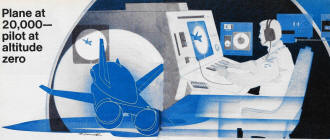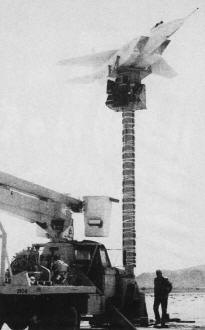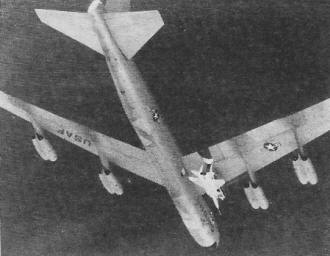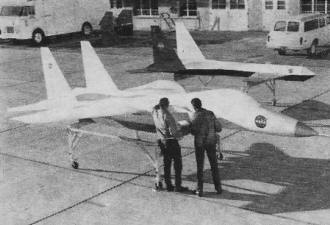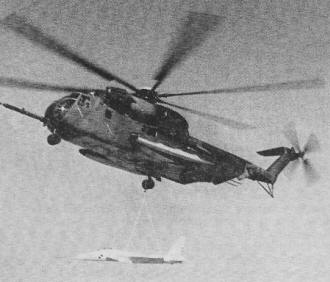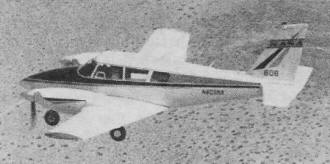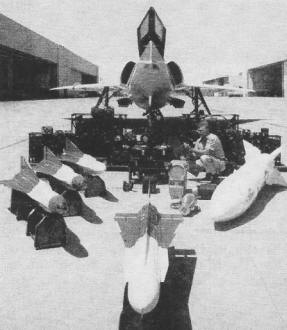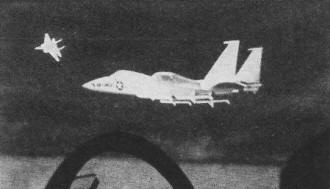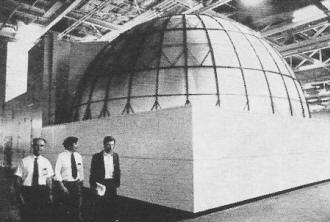Plane at 20,000 - Pilot at Altitude Zero |
||
RF technology has been a large part of new and upgraded aircraft development not just for studies of radio and radar performance, but also for remote control (R/C) of small- and full-scale prototype models. R/C began life as bulky vacuum tube systems with transmitters that needed to sit on the ground with a hand-held command box. Airborne systems carried lead-acid batteries for power*. Frequencies in the U.S. were in the 27 MHz citizens band, and then moved into 53 MHz (Ham band), 72 MHz (airborne only), and 75 MHz (ground only) bands. All modern R/C systems operate in the 2.4 GHz ISM band using spread spectrum modulation (FHSS and DSSS). Having been a builder and flyer of R/C models since the 1970s, I have read many articles about the role played by modelers over the years in modeling magazines and more general purpose magazines like this one in a 1974 issue of Popular Mechanics. Prior to the availability of super-powerful computers and sophisticated fluid dynamics simulation programs, model construction and testing in wind tunnels and in the air was the only way to test theories and actual performance. It is nearly the year 2020 and aircraft designers still build and test fly physical models in the research and development process. Scaled Composites, Burt Rutan's* famous futuristic, bleeding edge aircraft outfit that gave us SpaceShipOne, the Voyager round-the-world flyer, the VariEze and Long EZ homebuilts, and many other out-of-the-box designs familiar to aerospace enthusiasts, still uses R/C models today for proving design concepts prior to committing to full-scale construction. The company encourages employees to build and fly radio controlled model aircraft at home and during break times at work in order to engender a feel for what is required to make an airplane fly. * Often, if a model survived a bad landing (aka crash), the battery case would break and leaking acid would destroy the balsa wood framework. ** I want to be like Burt Rutan when I grow up ;-) Burt was an avid aircraft modeler as a youngster, having won many contests, per this Academy of Model Aeronautics (AMA) article. Plane at 20,000 - Pilot at Altitude Zero
by Frank A. Tinker The layout around me was deceptively simple. The display of flight and engine instruments was standard, the controls the same as those of a light plane or basic simulator. But this was neither simulator nor aircraft. I sat in a remote-control cockpit in NASA's control center at Edwards Air Force Base, California, aware that the instruments and controls before me had actually guided distant aircraft in test flights. These planes are unmanned RPVs - Remotely Piloted Vehicles - and the science of flying them is advancing so rapidly that some military men predict completely pilotless air combat in possible future wars. The technology could have civil applications too. Prior to flight, the scale-model F-15 undergoes static tests atop platform at Edwards Air Force Base. Model is under 24 feet long, weighs less than a ton. Actually, the "ghost flying" of airplanes goes back some decades. A remotely piloted Curtiss-Robin was flown in 1928. In recent years, the radio control of elaborate model aircraft has become common. A military ancestor of today's RPVs is the buzz bomb that Germany flew against Britain during World War II. But this pilot-less craft was a drone and not remotely controlled. It flew a preset course until a time switch cut off the fuel, causing it to dive. Much more advanced drones are part of today's American arsenal. A target version of the Teledyne-Ryan Firebee has been used for years by our Air Defense Command. The Firebee is used in simulated attacks from the sea. As it sweeps toward our shores, manned fighters try to intercept it and destroy it. Another Firebee carries a bomb and is guided by an operator located a safe distance away in a Hercules C-130 "mother ship." The drone is guided to the target initially by radar and on-board TV, then is "locked onto" the target, continuing the rest of the way automatically. The use of drones for reconnaissance and radar-jamming is one of the less-discussed developments of Vietnam and the surveillance contest we engage in with communist countries. Red China, for example, has exhibited a number of U.S. drones claimed to have been downed over her territory. In Vietnam, reconnaissance drones were widely used. They followed a pre-programmed route over the region to be scanned photographically or electronically. They also dropped propaganda leaflets (hence the nickname, Litterbug) and, in all probability, electronic snoopers. Returning to secure territory, they were recovered by helicopter, usually with an air grab, and made ready for another mission. Unlike the drones, which are equipped with an automatic pilot and follow, at least partially, a preprogrammed flight, the true RPV is completely controlled by a ground-based pilot. NASA is a leader in RPV development, starting a research program at Edwards AFB in 1969. Two years later, a twin-engine Comanche was equipped for remote control. Although a flesh-and-blood pilot has been aboard during test flights, he functions simply as a backup. The NASA remote pilot system uses telemetry to relay control commands to the plane and flight information back to the ground-based pilot. He uses the instruments as if he were flying blind, navigating mainly by radar and referring to a TV screen mounted over the instrument panel when he needs outside visual contact. The TV picture is relayed from a camera in the cockpit or the nose of the plane aloft. The test vehicle hangs below the big wing of a B-52, which will carry it up to launch altitude. Engineers check out F-15 model: a smaller, cheaper stand-in for a $57-million fighter plane. NASA research has already been put to practical use in the testing of the new F-15 superfighter. The full-scale fighter weighs some 40 tons and costs a reported $57 million. By contrast, the three-eighths-scale RPVs, identical replicas of the F-15, cost about $250,000 each and weigh less than a ton. Made of fiberglass strung over an aluminum frame, they have a wingspan of only 16 feet and are slightly over 23 feet long. The control surfaces are activated by a receiver that obtains its commands from the remote ground pilot. A battery-operated hydraulic system furnishes the muscle. In October, 1973, the first such model, complete with remote-control package, was air-dropped from a B-52 at 45,000 feet and maneuvered down to "pick up" altitude by remote test pilot Einar K. Enevoldson, who has been with the program since it began. Even on this first unpowered flight, the model was put through high angle of attack flight maneuvers. Then, at 15,000 feet, its 79-foot-diameter chutes were deployed and an air grab made by a waiting helicopter. Airline traffic is already controlled from the ground Actual landings are planned in the future, with the RPV powered by some type of rocket engine. A special TV system may also be installed to give the test pilot complete visual coverage. Right now, the RPV's assignment is to demonstrate the spin characteristics of the F-15, a risky maneuver for supersonic aircraft that results in one plane loss for every 60 such spin tests. In March, 1974, while NASA personnel kept their fingers crossed, Enevoldson pulled the RPV up into a stall, then kicked it into a violent spin. "It spun around too fast to count," reported one observer. But when the test pilot applied corrective controls, the small plane came out of the spin in the standard way. Although these flights are intended only to supplement tests with the full-scale F-15, the data obtained are of real value to the aircraft engineers involved. The tests also serve to point up other advantages of the RPV. The RPV's performance is not hindered by the physical limitations of a human pilot. You can forget about G-stress in turns and sudden pullouts. The absence of an on-board pilot also eliminates the need for a cockpit, oxygen systems, ejection seat and other safety devices, resulting in a lighter, simpler, cheaper plane. Small wonder that the Air Force is holding competitions for RPV contracts, has a full-time Drone-RPV office, and is now working on mini-RPVs that may be produced for as little as $20,000. It's estimated that even larger RPVs, capable of carrying considerable weaponry, need cost but a few hundred thousand dollars, or about one-tenth the going price of a cheap manned fighter. The Air Force is using Edwards AFB for its own tests of a reconnaissance RPV called the "Compass Cope." One prototype crashed after several successful flights during the summer of '73. No explanation for the accident was given. Two new prototypes built by Teledyne Ryan Aeronautical - not the maker of the crashed plane - were delivered to Edwards last spring and one of them was flown last summer. Chopper is on hand to catch experimental model on its descent by chute from altitude of 15,000 feet. This RPV is the "Compass Cope," a surveillance plane. Maiden flight to 25,500 feet was a success. Guided entirely by ground control, NASA's Piper Comanche cruises over California desert. Air Force and Teledyne officials were more than happy about the maiden flight, the results of which were announced as this issue of Popular Mechanics was ready to go to press. The plane stayed aloft for 1 hour and 50 minutes, "demonstrating takeoff, primary flight maneuvers and landing capabilities while under remote flight control of a ground operator," according to officials. "It flew at speeds up to 200 mph and at altitudes up to 25,500 feet... " Designed for high-altitude, long-endurance flight, the Compass Cope has an 81-foot wingspan, a fuselage 37 feet long, and is powered by a single turbofan jet engine with a rated thrust of 4050 pounds. Despite the earlier Compass crash, RPV research has gone forward smoothly. Still, officials are concerned about the possibility that an RPV will somehow break loose from its radio tether and take off for the wild blue yonder. A human pilot who could take over the controls was aboard NASA's Piper Comanche, but military testers use other safeguards. Chase planes follow the RPV, ready to take over control with their own radio units or to send a signal triggering the RPV's chutes. Though it has obvious military applications, is there also a role for the RPV in civil aviation? Proponents say the RPV would be ideal for hazardous types of flying-the testing of new planes, crop dusting and fighting forest fires. The work already accomplished with the F-15 scale model demonstrates that flight-testing would be a logical application. But crop dusting? Here the tolerances may be too small since the job frequently requires pilots to drag the landing gear" through the tops of foliage and fly by "instinct" more than by sight or instrument. On-board TV cameras would provide little help. Similarly, aerial forest-firefighting depends largely on the pilot's ability to "feel" his way through severe turbulence, with the plane often poised on the brink of a stall. Another factor is that there would not be any money saved in replacing a human pilot with a complex radio-control system. A much better case can be made for the application of RPV technology to the flying of commercial airliners. Though the average passenger's faith in gadgetry would be sorely tested by the knowledge that there was no human hand in the cockpit to bring him down safely, the fact remains that in recent years the control of all airline traffic has passed from the cockpit to the ground. The United or Pan Am pilot, for example, flies his jet in accordance with company rules and under the direction of a ground controller. His altitude is assigned and his route narrowly laid out between navigation points. The only time his skill really is needed is on takeoff, landing and during an emergency. During most of the flight the pilot does not physically control the plane. This is routinely done by an autopilot, which flies a much straighter, more level course than any human could. The autopilot can be coupled to the ground navigational system so that it steers unerringly along the desired course. Auto-pilots can even be tied in with the instrument landing system. Thus the plane is brought down the glide slope without a hand touching the controls, the power automatically reduced at flare-out and then completely chopped off at touchdown. If the pilot has become little more than an airborne monitor of a plane's systems, why does he even need to be aloft? It can be argued that it's safer to use a ground-control pilot who's a specialist in landings, someone who does nothing but bring down plane after plane during his duty shift. Would he not be superior at the job because of his constant practice? He would also have the advantage of working in a stable, comfortable environment instead of a cramped cockpit. A backup pilot could ride in the plane, ready to take over if the link between ground and plane should break down. If all this seems far-fetched, keep in mind that overseas there already are trains that are run in just this fashion. How far the automation of aircraft may go is anybody's guess right now, but the techniques and hardware are already with us. Now: Dogfights Without Planes Two F-15 fighters realistically projected on 360° wall screen inside an air combat simulator, as seen by pilot occupying cockpit centered in the 40-foot spherical chamber. Pilots in smaller simulators "fly" other planes, carryon dogfights. Simulator, in McDonnell Douglas Corp. St. Louis plant, is at left. Though the Air Force's new F-15 fighter is still being tested, pilots have already "flown" the bird in hundreds of dogfights against a variety of opponents. This trick is made possible through the use of an elaborate simulator - reportedly the only one of its kind in the world - at a McDonnell Douglas facility in St. Louis. McDonnell Douglas makes the F-15. The F-15 pilot sits in a cockpit that's a replica of the real thing. His assignment: to "maneuver" his aircraft so its guns are brought to bear on two opposing planes. The cockpit is situated in the center of a 40-foot spherical chamber, the wall of which forms a 360° screen for the projected images of the two opposing aircraft. These planes are being "flown" by pilots in smaller but similar simulators. They, in turn, see the F-15 projected on the walls of their chambers. When the F-15 pilot sees his "enemies," their size is directly related to range. They grow as they come closer, shrink as they fly farther away. As the pilots "fly" their aircraft, their stick, rudder pedal and throttle movements are translated into action that moves the images correspondingly. Performance characteristics of the aircraft involved are also taken into account. To further enhance the realistic quality of the experience, the pilots hear flight noises and the firing of their own missiles and guns. As they fly through tight turns, their bodies feel the pressure through specially designee G-suits. If a pilot pulls too many Gs, the lights grow dim to simulate a gradual blackout. Keeping track of all the variables in the three-aircraft dogfight is a computer with the capability of executing some 2,500,000 instructions per second. It's the hard-working computer that keeps the action going. The images are obtained from models of the full-sized planes. They are shot with a TV camera - at a variety of attitudes - to yield realistic projections of dives, loops and other maneuvers. The complex simulator system is currently used as an engineering design aid in fighter research and development. A future possibility, according to McDonnell Douglas officials, is to use the simulator to train pilots in air-to-air combat maneuvering. Members of the McDonnell Douglas simulation department recall a remark made by Irv Burrows, the company's chief test pilot, after he had piloted the F-15 on its first actual flight: "It flew just like the simulator." That's the kind of talk the simulation experts like to hear.
Posted December 9, 2019 |
||

